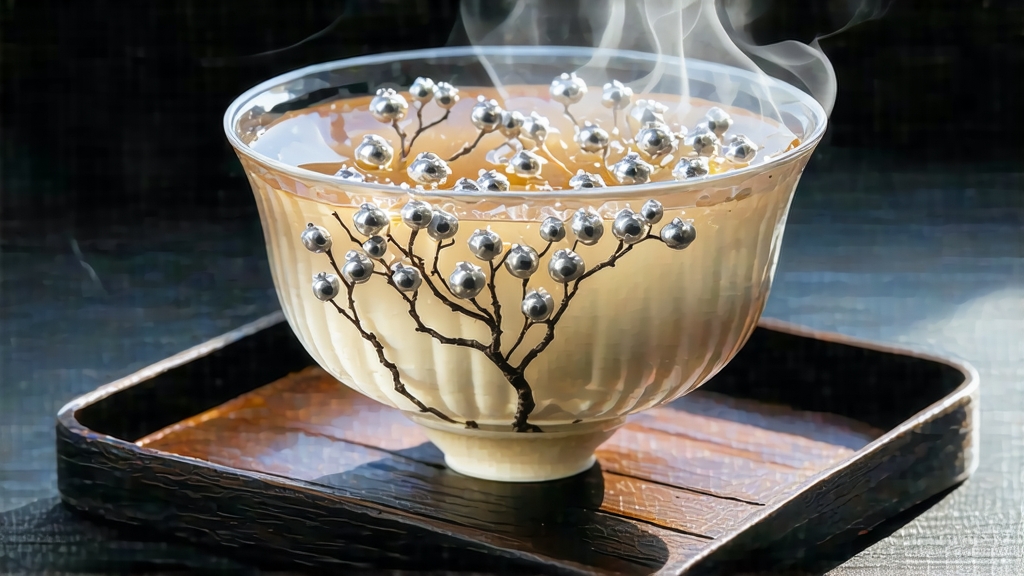
Among the six great families of Chinese tea, white tea is the least theatrical yet the most elusive. It is picked, withered, and dried—nothing more—but in that seeming simplicity lies a universe of fragrance, texture, and calm. Within this quiet kingdom, Bai Hao Yin Zhen, literally “White-Hair Silver Needle,” reigns as the purest expression of the leaf. Composed solely of unopened buds plucked for only a few spring mornings each year, Silver Needle is the white tea that connoisseurs reach for when they want to taste the moonlight that Chinese poets insist is trapped inside every bud.
History: from imperial tribute to global muse
The first verifiable record of “white tea” appears in the Song Dynasty treatise Da Guan Cha Lun (1107 CE), yet those cakes were green tea that happened to look pale. True bud-white tea emerged much later, during the late Ming and early Qing, when the coastal county of Fuding in Fujian perfected the technique of sun-withering. By the Daoguang era (1821-1850) Silver Needle was already imperial tribute, wrapped in silk and escorted north by horseback to the Forbidden City. Foreign merchants encountered it in the late nineteenth century when Fuding became a treaty-port export hub; European medical journals of the 1890s praised its “light tonic properties,” planting the seed for today’s wellness fascination. In 2008 the European Union granted Fuding white tea Protected Designation of Origin status, a rare honor for a Chinese agricultural product, cementing Silver Needle’s place on the world stage.
Micro-terroir: why Fuding tastes like peony and sea breeze
Fuding lies at 27° N latitude, where the Wuyi Mountains descend toward the East China Sea. Red-yellow lateritic soil, rich in iron and quartz, drains quickly, forcing the tea bush to struggle and concentrate amino acids. The Daiyun mountain range traps humid maritime air, creating 80 % relative humidity at dawn—ideal for slow withering. Two local cultivars dominate: Fuding Da Bai (Big White) and Fuding Da Hao (Big Hair), the latter bearing buds that can reach 3.5 cm and are cloaked in so much down they look dipped in icing sugar. This down is key: it contains more volatile terpenes than the leaf blade itself, giving authentic Silver Needle its signature lilac-and-honey aroma impossible to replicate elsewhere.
Plucking: the silent arithmetic of spring
Official Chinese white-tea standards allow only ten picking days, usually between March 15 and April 5, when the bud reaches “one flag, one shoot” status: the bud stands erect, sheathed by a tiny, half-open leaf resembling a pennant. Experienced pickers harvest at dawn while dew still glistens, because surface moisture acts as a microscopic magnifying glass during sun-withering, caramelizing the bud’s edges. A master can pluck 2,000 buds per hour; 30,000 buds—an entire day’s work—yield just 500 g of finished tea. This arithmetic explains why top-grade Silver Needle often costs more per gram than silver itself.
Craft: the art of doing almost nothing
Unlike green tea that is pan-fired or oolong that is bruised, white tea is coaxed rather than cooked. The traditional Fuding method has three variables: sun, air, and time. Buds are spread on water-woven bamboo trays 1.5 cm thick and placed at a 15° angle facing the rising sun for 20–40 minutes, depending on UV index. Workers gently turn the buds every ten minutes with a feather fan to ensure even light exposure. When the bud surface reaches 28 °C it is moved indoors to a ventilated loft where it undergoes 36–48 hours of ambient withering at 22 °C and 65 % humidity. During this interval enzymes convert catechins into complex theaflavins, while lipids break down into floral aldehydes—chemistry that no machine can accelerate without flattening the cup. Finally the tea is baked for 15 minutes at 50 °C using charcoal embers covered with ash; this “soft fire” lowers moisture to 5 % without roasting character. The entire cycle respects the Daoist principle of wu-wei: action through non-action.
Grades and market reality
Chinese national standard GB/T 22291 divides Silver Needle into two grades—Special and First—but the market recognizes finer distinctions. “Beimu” (Jade Eyebrow) refers to buds harvested before the